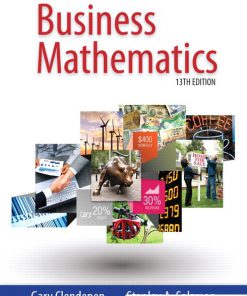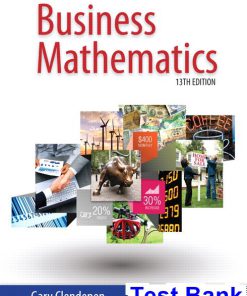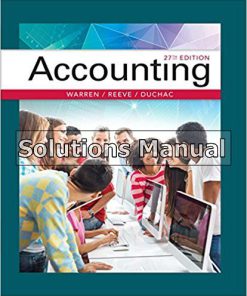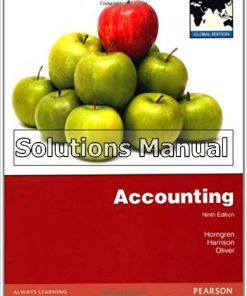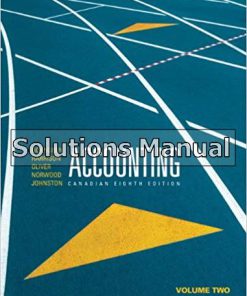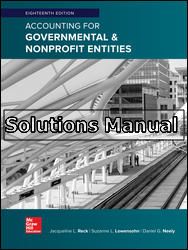Nature of Mathematics 13th Edition Smith Solutions Manual
You may also like
Instant download Nature of Mathematics 13th Edition Smith Solutions Manual pdf docx epub after payment.
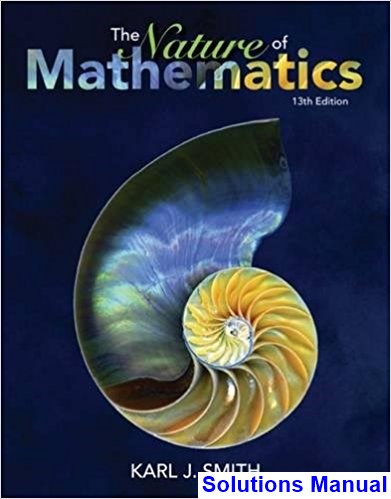
Product details:
- ISBN-10 : 1133947255
- ISBN-13 : 978-1133947257
- Author:Karl J. Smith
Experience mathematics–and develop problem-solving skills that will benefit you throughout your life–with THE NATURE OF MATHEMATICS and its accompanying online learning tools. Karl Smith introduces you to proven problem-solving techniques and shows you how to use these techniques to solve unfamiliar problems. You’ll also find coverage of interesting historical topics, and practical applications to settings and situations that you encounter in your day-to-day world, such as finance (amortization, installment buying, annuities) and voting. With this book’s guidance, you’ll both understand mathematical concepts and master the techniques.
Table of contents:
Prologue: Why Math? A Historical Overview.
1. THE NATURE OF PROBLEM SOLVING.
The Nature of Problem Solving. Problem Solving. Inductive and Deductive Reasoning. Scientific Notation and Estimation. Summary.
2. THE NATURE OF SETS.
Sets, Subsets, and Venn Diagrams. Operations with Sets. Applications of Sets. Finite and Infinite Sets. Summary.
3. THE NATURE OF LOGIC.
Deductive Reasoning. Truth Tables and the Conditional. Operators and Laws of Logic. The Nature of Proof. Problem Solving Using Logic. Logic Circuits (Optional). Summary.
4. THE NATURE OF NUMERATION SYSTEMS.
Early Numeration Systems. Hindu-Arabic Numeration System. Different Numeration Systems. Binary Numeration System. History of Calculating Devices (Optional). Summary.
5. THE NATURE OF NUMBERS.
Natural Numbers. Prime Numbers. Integers. Rational Numbers. Irrational Numbers. Groups, Fields, and Real Numbers. Discrete Mathematics. Cryptography (Optional). Summary.
6. THE NATURE OF ALGEBRA.
Polynomials. Factoring. Evaluation, Applications, and Spreadsheets. Equations. Inequalities. Algebra in Problem Solving. Ratios, Proportions, and Problem Solving.
Percents. Modeling Uncategorized Problems. Summary.
7. THE NATURE OF GEOMETRY.
Geometry. Polygons and Angles. Triangles. Similar Triangles. Right Triangle Trigonometry (Optional). Mathematics, Art, and Non-Euclidean Geometries (Optional Sections). Summary.
8. THE NATURE OF MEASUREMENT.
Perimeter. Area. Surface Area, Volume and Capacity. Miscellaneous Measurements (Optional). U.S.-Metric Conversions. Summary.
9. THE NATURE OF NETWORKS AND GRAPH THEORY.
Euler Circuits and Hamiltonian Cycles. Trees and Minimum Spanning Trees. Topology and Fractals. Guest Essay: “What Good Are Fractals?” . Summary.
10. THE NATURE OF GROWTH.
Exponential Equations. Logarithmic Equations. Applications of Growth and Decay. Summary.
11. THE NATURE OF SEQUENCES, SERIES, AND FINANCIAL MANAGEMENT.
Interest. Installment Buying. Sequences. Series. Annuities. Amortization. Summary of Financial Formulas. Summary.
12. THE NATURE OF COUNTING.
Permutations. Combinations. Counting without Counting. Rubik’s Cube and Instant Insanity (Optional). Summary.
13. THE NATURE OF PROBABILITY.
Introduction to Probability. Mathematical Expectation. Probability Models. Calculated Probabilities. GUEST ESSAY: “EXTRASENSORY PERCEPTION”. “Bayes’ Theorem”. The
Binomial Distribution (Optional). Summary.
14. THE NATURE OF STATISTICS.
Frequency Distributions and Graphs. Descriptive Statistics. The Normal Curve. Correlation and Regression. Sampling (Optional). Summary.
15. THE NATURE OF GRAPHS AND FUNCTIONS.
Cartesian Coordinates and Graphing Lines. Graphing Half-Planes. Graphing Curves. Conic Sections.Functions. Summary.
16. THE NATURE OF MATHEMATICAL SYSTEMS.
Systems of Linear Equations. Problem Solving with Systems. Matrix Solution of a System of Equations. Inverse Matrices. Modeling with Linear Programming (Optional). Summary.
17. THE NATURE OF VOTING AND APPORTIONMENT.
Voting. Voting Dilemmas. Apportionment. Apportionment Flaws. Summary.
18. THE NATURE OF CALCULUS (OPTIONAL).
What Is Calculus? Limits. Derivatives. Integrals. Summary.
Epilogue: Why Not Math? Mathematics in the Natural Sciences, Social Sciences, and in the Humanities.
Appendices.
A. Glossary.
B. Selected Answers.
C. Index.
People also search:
what is the nature of mathematics as a language essay
reflection about nature of mathematics brainly
nature of mathematics as a discipline
nature of mathematics a science of measure
nature of a mathematics
argue about the nature of mathematics
aesthetic nature of mathematics
beliefs about nature of mathematics



